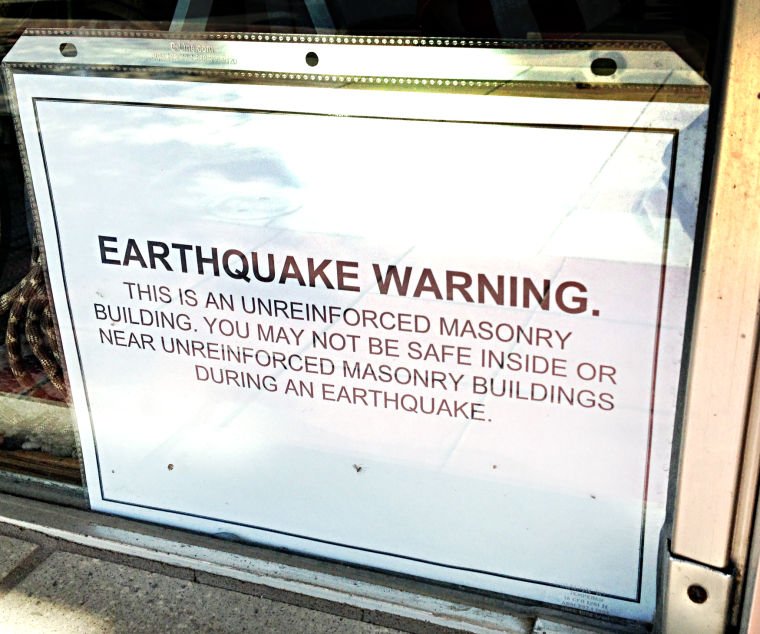
GILROY—In a first-of-its-kind move, the city of Gilroy has filed criminal complaints against the owners of two downtown buildings—two of many in the city’s core—deemed structurally unfit to survive a high-magnitude earthquake, in an effort to clean up what officials declare is a public safety hazard.
The owners of the Creamery and Water Store buildings, located at 7491 Railroad Street and 7515 Monterey Street, respectively, face legal action for allegedly ignoring dangerous conditions at their buildings for more than a year, Mayor Don Gage confirmed Monday. The Creamery was listed on the National Registry of Historic Places in 1982 among other buildings “worthy of preservation” because of their significance in American history and culture.
“They don’t want to sell it, they don’t want to fix it and they don’t want to take them down. It’s criminal,” Gage said. “They’ve been blowing us off. The only way we can get them to respond is to take legal action.”
The city’s contracted legal firm, San Jose-based Berliner Cohen, filed criminal complaints against Lynette Hill, the listed owner of the Creamery, and Cynthia Boxall, the listed owner of the Water Store, according to Development Center Manager Lee Butler.
“Those are the only two properties where we’re pursuing that course of action right now,” Butler said.
However, outside of the legal action for those two buildings, Butler said “notable progress” has been made with other similar structures in downtown Gilroy.
A total of 15 buildings in the heart of the Garlic City have been identified as unreinforced masonry, or URM, structures, and 13 of them need to be retrofitted to meet the state’s earthquake codes, or else demolished. That’s three fewer URM buildings since December.
“There has been progress, but it’s been at a snail’s pace,” said Gary Walton, downtown advocate and property owner.
That’s due in part, Walton said, to the city-created bureaucracy that arose after officials began fining building owners for non-compliance with the city ordinance in 2013. Property owners should get more involved in the process, he said, but the city isn’t making itself any friends.
“We (property owners) all agree the way it was handled from the get-go wasn’t the best solution to the problem, and while the city says they can’t change the past, you can make it a lot easier to get the job done and make up for the mistakes of the past,” Walton added.
Moreover, Walton is critical of the city’s move to file criminal complaints against Hill and Boxall, saying it’s “not the right approach.
“It costs everybody more money, it doesn’t solve the problem and it just diverts attention from what we should be doing—working together to get this problem solved.”
The fines in some cases amount to tens of thousands of dollars and remain unpaid since they were levied in 2013, according to Steve Ashford, another downtown property owner.
Delinquent property owners who cannot pay $30,000 in fines won’t have the money to pay for engineering estimates or contractors to retrofit the buildings—a process that is twice to three times more expensive, Ashford said.
A contractor himself, Ashford has been performing repairs on his property—Ashford’s Heirlooms on Monterey Street.
“The fees are really holding things back,” he said, addressing the council at its July 1 meeting. “I think there are a few buildings people would move forward on if they thought these fees weren’t something they were being held to.”
According to Gage, the city started fining nonresponsive building owners for noncompliant buildings in 2013 “because we wanted progress down there.”
“It was uncharted territory. If we hadn’t done that, we wouldn’t be where we are today,” the mayor said.
Councilman Perry Woodward, who serves on the city’s URM Task Force along with Gage and a number of property owners, said progress has sometimes been like pulling teeth. But the city and building owners are working together, in most cases, to fix downtown’s “broken smile” one building at a time, he said.
There are a handful of property owners who have not communicated with the city or made an effort to bring their buildings into compliance with the state earthquake code—even since 2013, according to Butler.
Since the fines were first levied against nonresponsive or noncompliant owners, the city council has discussed whether to offer URM owners who’ve complied with the law some relief from the fines.
The council has not granted relief for any property owner by way of action on the dais, but Gage said they would all be reviewed on a case-by-case basis once the retrofitting work is completed.
“We have to have a little bit of patience and make sure (we help out) those who are performing,” he said, adding that property owners will need to come to the council to ask for relief from any fines.












